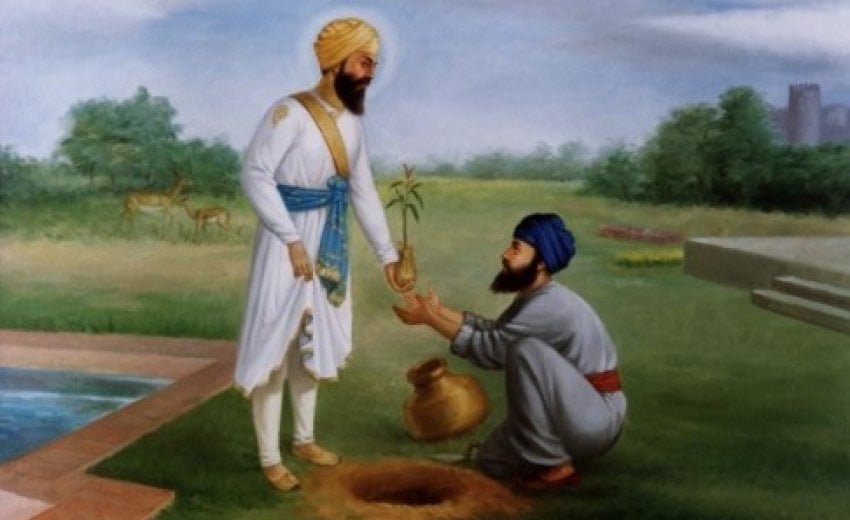The Akal Takhat holds a special place for Sikhs, serving as their highest authority in both worldly and spiritual matters. Back in July 2009, Jathedar Gurbachan Singh, the leader of the Akal Takhat, emphasized the duty of Sikhs towards the environment, calling it a moral and religious obligation. This statement was well received as a positive step towards environmental consciousness.
During a gathering aimed at cleaning the polluted Kali Bein, a river in Sultanpur, the Jathedar addressed the Sikh community, urging them to prioritize the cleanup of natural water sources over the construction of Gurdwaras, no matter where they were in the world. This directive from the leader of a religious institution to safeguard the environment was significant and binding, especially considering the pollution of Kali Bein due to industrial waste and public litter.
Initiatives for cleanliness
Baba Balbir Singh Seechewal, a Sikh leader, worked alongside people to clean a river and plant trees along its banks, raising awareness about caring for the environment. Inspired by his efforts, the Head of the Shiromani Gurdwara Parbandhak Committee decided that instead of offering traditional 'parsad', the Gurdwara would distribute trees. This shift marked a significant step in protecting the environment.
In another instance, Sikh leaders from India and around the world gathered in New Delhi for the EcoSikh Conclave in July 2009. Their aim was to highlight the Sikh community's dedication to safeguarding the environment amid the challenges posed by climate change and global warming.
Guru Har Rai developed Kiratpur Sahib as a town of parks and gardens
Guru Har Rai, the seventh Sikh Guru, transformed Kiratpur Sahib into a peaceful town filled with lush parks and gardens. By planting vibrant flowers and fruitful trees across the area alongside a tributary of the Sutlej River, he made the town incredibly beautiful. This attracted beautiful birds and made it a serene and ideal place to call home.
In Sikh beliefs, taking care of the environment is seen as part of a connected and integrated approach to life and nature.They believe that everything in existence comes from the same source and shares the same destiny. This perspective encourages people to understand their role in the grand scheme of creation and to treat all living beings with love, kindness, and fairness. To be in harmony with God involves living harmoniously with all of God’s creations.
Recognizing the inherent link between humanity and nature, the Head Priest of Akal Takhat and President of SGPC have called upon all Sikhs to protect the environment.
Sikh leaders unveil 'Green' Plan, Community Response to Check Climate Change.
SCORE's initiative, "EcoSikh," outlines a five-year strategy aimed at spreading awareness about environmental issues within the Sikh community, both in India and internationally. The Sikh Council on Religion and Education (SCORE), based in the USA, orchestrated a summit focused on the environment. Notable attendees included UN Assistant Secretary-General Olav Kjorven and Victoria Finlay from the UK-based Alliance of Religions and Conservation (ARC).
During the EcoSikh meeting, Olav Kjorven emphasized the historical role of religions in helping societies understand and respond to challenges. He highlighted the need for religious leadership to address climate change by drawing upon spiritual wisdom and moral guidance. He quoted a verse from Guru Nanak that likened the sky to a platter and compared the sun and moon to lamps. (Ed.: Sohilaa/Aarti).
Several notable figures including Union Cabinet Minister Dr. Manohar Singh Gill, SGPC Secretary Dilmegh Singh, DSGMC President Paramjit Singh Sarna, former Supreme Court Judge Justice Kuldeep Singh, MP Tarlochan Singh, and Vikram Singh Sahney of World Punjabi Organization gathered to support a five-year ‘greening plan’. Their plan involves transforming Gurdwaras and schools into ecologically sound buildings by implementing energy-efficient practices and using sustainable building materials. Additionally, they aim to integrate environmental education into the Sikh education curriculum as a long-term commitment to fostering ecological consciousness.
In his opening statement, Justice Kuldeep Singh, often referred to as the 'Green Judge,' expressed his happiness at seeing the Sikh community embrace the vital task of promoting eco-friendly practices. He emphasized the responsibility Sikhs hold in honouring and preserving the environment, highlighting that a Sikh's life finds fulfillment through reverence for nature. Justice Singh underscored that environmental ethics have long been integral to India's principles and values, emphasizing the historic respect accorded to the environment. However, he lamented the current state where pollution threatens this reverence.
Earth, air, water, life and all activities connected with life come under the umbrella of environment.
saachay tay pavnaa bha-i-aa pavnai tay jal ho-ay.
jal tay taribhavan saaji-aa ghat ghat jot samo-ay.
(SGGS Sri Raag, M.1, p.19)
The supreme scripture for Sikhs, Sri Guru Granth Sahib (SGGS), teaches that everything originated from the True Lord. Air came first, then water, and from water, the entire universe emerged. In every living being, there's a divine spark of the Lord's Light.
This means that air, water, earth, and life all come from the True Lord and carry a sacred essence. Harming any of these elements harms the True Lord dwelling within them. For Sikhs, this understanding makes earth, air, water, and life all deeply revered.
In the Sikh teachings, every child learns about Japuji, a sacred verse by Guru Nanak that begins with "Ik Oankar," signifying the presence of the One Creator who made everything—the universe, humans, animals, plants, planets, and more. This emphasizes the equality and oneness of all creation, as everything belongs to and is connected by the One Creator.
aapeenHai aap saaji-o aapeenHai rachi-o naa-o.
duyee kudrat saajee-ai kar aasan ditho chaa-o.
(SGGS, Asa di Var, p.463)
In this serene melody recited early in the morning, it's believed that after creating Himself, God brought forth nam, the Divine name, as the initial expression of His sacred presence. Following this, kudrat or nature was created, entirely sustained and imbued by nam. In this way, the Creator not only witnesses creation but also resides within it, showing an intricate connection between the two. This emphasis on interconnectedness is particularly highlighted in eastern faiths. It naturally fosters a deep sense of appreciation and reverence for the blessings of nature, seen as manifestations of God's Grace.
balihaaree kudrat vasi-aa.
tayraa ant na jaa-ee lakhi-aa. ||1|| rahaa-o. (SGGS p.469)
I am totally indebted to you, Oh Infinite Lord,
who dwells within nature and whose limits cannot be told.
Last lines of Japuji say:
pavan guroo paanee pitaa maataa Dharat mahat.
divas raat du-ay daa-ee daa-i-aa khaylai sagal jagat. (SGGS p.8)
Air is our Guru, water our father, and great earth is our mother;
Day and night are the male and female nurses, in whose lap the whole world plays.
pa-un paanee Dhartee aakaas ghar mandar har banee. (SGGS p.723)
Air, water, earth and sky - the Lord has made these His home and temple.
The Sri Guru Granth Sahib stresses the vital role of Air, Water, and Earth in sustaining life. It regards the Earth as a mother figure deserving of our utmost respect. Sikhs are urged to be mindful in their daily lives, ensuring no harm befalls these essential elements. The Gurus' teachings strictly oppose any pollution of these crucial resources.
According to the teachings, God is the creator and overseer of the universe and the world. All events occur under God's guidance, known as the Order (Hukam). God's ways and intentions remain beyond human comprehension, yet God not only orchestrates this vast existence but also watches over it with nurturing care and compassion, akin to a benevolent and supportive parent.
The world, like all creation, is a manifestation of God. Every creature in this world, every plant, every form is a manifestation of the Creator. Each is part of God and God is within each element of creation. God is the cause of all and He is the primary connection between all existences.
In the world God has created ,he has also provided each species and humans with means of support and nurturing.
khaak noor kardaN aalam dunee-aa-ay.
asmaan jimee darkhat aab paidaa-is khudaa-ay. ||1|| (SGGS p.723)
The Lord infused His Light into the dust, and created the world, the universe.
The sky, the earth, the trees, and the water - all are the Creation of the Lord. (1)
narnarah namaskaaraN.
jalan thalan basuDh gagan ayk aykaNkaaraN. ||1|| rahaa-o. (SGGS p.901)
I humbly bow to the Lord, the Supreme Being.
The One, the One and Only Creator Lord permeates the water, the land, the earth and the sky. ((1)(Pause))
Guru Nanak saw no distinction between creation and the creator, viewing God within nature itself. If he were to witness the current pollution of the natural world, he might have been surprised and saddened by the shift toward negativity.
Rabindranath Tagore found the depiction of the relationship between nature and God in the hymn "Aarti" profoundly moving, considering it the finest poetry he had ever encountered.
gagan mai thaal rav chand deepak banay taarikaa mandal janak motee.
Dhoop mal-aanlo pavan chavro karay sagal banraa-ay foolant jotee. ||1||
kaisee aartee ho-ay. bhav khandnaa tayree aartee.
anhataa sabad vaajant bhayree. ||1|| rahaa-o.
sahas tav nain nan nain heh tohi ka-o sahas moorat nanaa ayk tohee.
sahas pad bimal nan ayk pad ganDh bin sahas tav ganDh iv chalat mohee. ||2|
sabh meh jot jot hai so-ay.
(SGGS, p.13)
The hymn describes the divine presence in everything around us. The sun and moon are seen as radiant lamps and the stars as glistening pearls adorning the sky's bowl. Fragrances like sandalwood are likened to the incense of a sacred offering, while the wind becomes a gentle fan and the plants, exquisite flowers for the Divine. The hymn celebrates the Creator's relationship with creation, describing the vastness of the True Lord's nature. It portrays how the universe itself is an intricate form of worship, where light, nature, and celestial elements all come together in reverence and prayer to the Divine.This is how the real prayer to God is done.
Guru Nanak's strong connection to nature was a key part of his closeness to God, leading to profound spiritual experiences. Throughout his travels, he chose to reside under trees in nearby jungles rather than in constructed houses. This choice reflected his deep love for the natural world and its role in his spiritual journey.
Originally published on March 12th 2010 by Dalvinder Singh Grewal on sikhphilosophy.net

